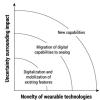Business Transformation Requires Transformational Leaders
Leadership and teaming skills are front and center in times of rapid change. Meet today’s constant disruption head on with expert guidance in leadership, business strategy, transformation, and innovation. Whether the disruption du jour is a digitally-driven upending of traditional business models, the pandemic-driven end to business as usual, or the change-driven challenge of staffing that meets your transformation plans—you’ll be prepared with cutting edge techniques and expert knowledge that enable strategic leadership.
Recently Published
Software has been a crucible of management practice. Since software development requires a wide range of types of work, from mostly routine to highly innovative, and software is often delivered into highly volatile environments, no single management solution can fit all needs.
It is difficult to think “outside the box” when you don’t realize that you are inside a box. This is what happens when enterprises get seduced into romanticizing abstract ideas such as “architecture” or “agility.” It is important to steel oneself to the allure of these siren calls and stay focused on what is of value to the business.
Here in Part III of this three-part Executive Update series, we investigate current techniques and best practices for managing IT project portfolios and strive to create a solid bridge between corporate strategy and IT investments. ITPM is one of the critical tools available to an EA practice to better ensure IT alignment with business strategy.
A Hybrid Approach to Decision Making
This Executive Update explores the mechanics behind various decision-making models and examines the boundaries and use cases for each. It discusses the qualitative value that experience or intuition can add to data-driven quantitative analysis, thereby providing the best approach to decision making. It is an attempt to understand the science of the art of decision making.
Three Waves of Wearables
When we talk about wearables, most of us have one or two specific devices in mind that we use to add tangibility to our thinking. Yet the examples that occur to us most readily are typically those that require the least effort, rather than those that lend themselves to thorough consideration.
[From the Editor: In 2008, Cutter Fellow Rob Austin described the principles that need to be learned — and unlearned — in an innovation economy. Although nearly a decade has passed since he first wrote the words, his guidance still rings true today. We share his message again here.]
Industry/domain-specific IoT solutions are typically built on the provider’s IoT platform, implementing frameworks and expertise designed to support popular IoT and Industrial Internet use cases. This Advisor provides some examples of what is available on the market.
Organizational transformations come in many forms, including divestures, joint ventures, taking a business public or private, and general market reorientations. In this Advisor, we explain enterprise architecture (EA) in relation to one type of strategic transformation: acquisitions. Acquisitions are one way that businesses seeking to digitize use to accelerate the journey to their destination and, in our experience, to specifically complement their innovation-management pipeline.















